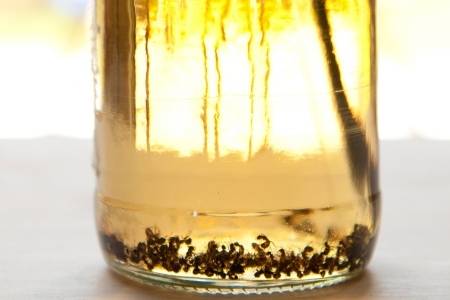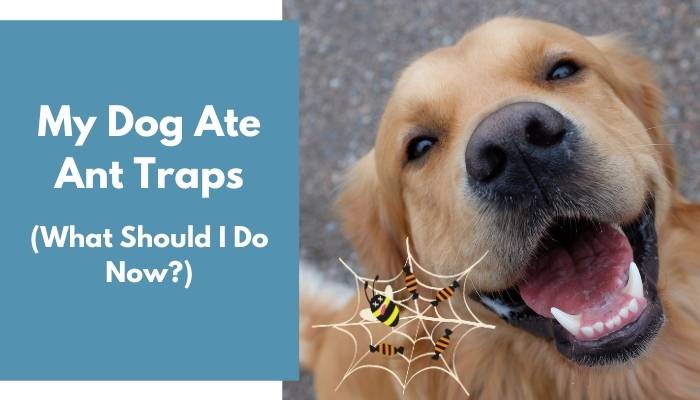Nowadays, manufacturers make ant traps to be pet-friendly. It means that they do make ant-traps while keeping in mind that they can attract our pets. Still, these items remain toxic, and while they won’t do grave harm, they can still cause some issues.
So, you may ask: my dog ate ant traps: what should I do now? If your dog ate ant traps, the first thing you need to do is understand how your dog’s condition is by observing it. If your pet shows any signs of complications, it would be best to contact a vet right away. Moreover, prevent such incidents from happening again.
Ant traps are essential in a home where ants forage food all the time. They can be a nuisance, and so you can’t help but have one lying around. However, it may not do well if you have a curious dog loitering around.
In this article, we’ll tackle everything you need to know about ant traps, particularly how to deal with them, such as if eaten by your dog. This way, you’ll know what to do if your pet eats such.
Without further ado, let’s get into it!
Contents
- 1 What should I do if my dog ate an ant trap or poison?
- 2 Are ant traps toxic to dogs?
- 3 How much ant poison will kill a dog?
- 4 What happens if a dog licks an ant trap?
- 5 How do you flush the poison out of a dog’s system?
- 6 Dog ate ant poison granules – what to do?
- 7 How to prevent dogs from eating ant traps?
- 8 Summary
- 9 Resources
What should I do if my dog ate an ant trap or poison?
If your dog ate an ant trap, it might show any signs of problems or issues. Some dogs would remain healthy and won’t have any issues. Thus, you don’t need to do anything about it.
On the other hand, some dogs may show symptoms that indicate a health complication or issue. In this case, you may need to respond by taking it to the vet and have it checked.
As pet owners, we want to ensure our pets remain safe even if they go overboard playing now and then. Thus, if you see your pet ate a wasp, here are some things you can do.
Take the remaining ant traps away.
As soon as you learned your dog ate ant traps, the first thing you’ll need to do is prevent it from getting worse. Thus, it would be best if you took the remaining ant traps away.
This way, you’ll prevent your pet from re-accessing it and won’t ingest more of it.
If you can’t take it away, you can secure it or put it somewhere your pet can’t reach.
If your dog continues to loiter in the area, it would be best to keep it inside the house or anywhere far from it. The last thing you’ll want is for your pet to see more ant traps to eat.
For this reason, it would always be best to secure your pet by taking it inside the house. If it happened inside, put your pet in a room where there are no ant traps.
This way, you’ll prevent your pet from accessing more traps. It will also help you examine your pet for any signs or symptoms.
Observe your pet.
Observe your pet for adverse effects after eating the ant trap. This way, you can use it as your hint if your dog needs an expert’s help or if it will be alright without any help at all.
Some dogs may have an adverse reaction from ant traps, while others may feel alright. For this reason, it would be best to ensure your pet’s health is okay by checking on it for signs of problems.
Health complications may come to the surface in the next hours or the following days. Thus, it’s ideal for you to continue checking your pet’s health in the next few days.
If your pet shows any signs or symptoms, consult the vet immediately. If, after a few days, your pet seems alright, then you don’t have to do anything further regarding that matter.
Understand the situation.
Understanding what happened is the key to know the proper response and help your dog needs.
For instance, you need to know some information by answering the following questions.
- How long has it been since your pet ate ant traps?
- How much of the trap did your pet eat?
- Does the trap have anything toxic with it?
As long as you understand what happened, you’ll have all the information to know if your pet needs immediate attention.
Moreover, it will help you understand how grave or how simple the incident was.
Contact your vet.
To ensure your pet’s safety, you can take it to the vet. Or, you can at least have a consultation through a call.
If your pet shows some symptoms or adverse reactions, a physical check-up may be necessary. However, if your pet seems alright, calling your vet would still help.
Through a consultation, you can ensure your pet receives the proper treatment. You will receive recommendations and advice from an expert.
You May Also Read – My Dog Ate Bee: What Should I Do Now?
Are ant traps toxic to dogs?
Ant traps vary for every brand, and so the toxicity may also vary. Still, ant traps these days are usually free of any toxic components, making them pet-safe.
Now, although ant traps don’t have any toxic components, it doesn’t mean your pet won’t experience any effects after eating.
Ant traps, if taken in large amounts, can still cause digestive issues. Among the usual effects would be an upset stomach or vomiting.
For this reason, always think of ant traps as something your dog shouldn’t access.
The problem with ant traps would likely be from the plastic housing rather than the poison inside.
If swallowed, the said plastic can cause lacerations, punctures, or even a blockage.
As soon as you find out your pet ate such, it would be best to contact your vet immediately and seek its help.
Moreover, it would be best to prevent such incidents again in the future by placing your traps somewhere your dog can’t reach.
It would also help if you secured the trash bins where you put your used traps away.

How much ant poison will kill a dog?
There’s no exact way of telling how much ant poison can kill a dog. The truth is, it will vary on many factors. Among these are:
The size of your pet
If your dog is a small one, a small amount of poison would be enough to cause severe symptoms. Taking in a little bit more would be lethal for them, mostly if left unchecked.
Another thing to consider is that some breeds are sensitive to poison, while others may be more resistant.
As always, make sure you consult a vet for this matter to understand more about the risks that come with your pet.
The type of ant poison
Ant poison back in the days doesn’t consider pets. Thus, they usually aren’t pet-safe. If you’re still using such, your pet may be in danger even with just a small amount.
However, if your ant trap is pet-friendly, it means the poison won’t do much harm to your dog. Still, it may cause some minor issues.
Your pet’s health condition
If your pet has a health complication before eating an ant trap, it may worsen and cause your pet’s former issue to get triggered.
The type of ant trap
Some ant traps are granule baits, and they vary in their effects on pets if ingested.
Some ant traps come as tiny plastic that won’t cause an issue unless ingested.
You May Also Read – My Dog Ate Wasp: What Should I Do Now?
What happens if a dog licks an ant trap?
If your dog only licks an ant trap, it won’t likely cause any issue. Ant traps these days are usually pet friendly, designed to be safe even if pets start to play with them.
The only real issue would be if your pet starts ingesting it and swallows it in large amounts.
In this case, your pet may suffer from an upset stomach or diarrhea. Worse, the traps may cause a blockage or other severe symptoms.
As a general rule of thumb, don’t leave your pet unattended near an ant trap. If possible, put the trap in a place your pet can’t reach.
This way, you’ll avoid such unwanted incidents from happening.
How do you flush the poison out of a dog’s system?
The usual procedure in flushing out a toxin or poison out of a dog is by inducing the pet to vomit. Still, it’s not something you should do, especially if you don’t have an expert’s approval.
If you call a vet, you may get asked the following steps:
Your vet may advise you to take your pet to the nearest veterinary clinic.
- Your vet may ask you to induce vomiting at home by using hydrogen peroxide.
- Your vet may ask you to bathe your pet if the skin comes in contact with a toxin.
- Your vet may ask you to call animal poison control for assistance.
As a reminder, always follow what your veterinarian asks you to do. Moreover, don’t leave any details behind. In short, tell your vet every information you know about the incident.
This way, you can be confident your pet receives proper diagnosis and treatment.
Dog ate ant poison granules – what to do?
One good thing about ant poison granules is that they are not as toxic to dogs as ants.
Since ants are tiny, they only need a tad bit of poison to get killed. Such an amount wouldn’t be enough to put your pet at risk.
Now, it doesn’t mean your pet will be excellent after eating such. If your dog overeats, the poison can still cause some health issues such as vomiting or diarrhea.
The only thing you need to do is monitor your pet’s condition and check for a few days if you think it needs some help.
Another thing is to prevent your pet from accessing the poison in the future.
How to prevent dogs from eating ant traps?
A dog eating ant traps incident isn’t new. However, it should be a lesson to prevent it from happening again.
Here are some of the things you can do to prevent your pet from eating ant traps again.
Place ant traps somewhere unreachable.
The first thing you need is to consider a place where you can place your ant trap. It would be ideal for putting it somewhere your dog can’t see and reach.
This way, you can be sure your pet won’t get its hands on such a poison again.
Use pet-friendly ant traps.
The market has a wide variety of options to offer to help you with your ant problems.
If you want to use ant traps, make sure it’s pet-friendly. It’s applicable for pet owners who have curious buddies roaming around.
Divert your dog’s attention.
Another thing you can do is to divert your dog’s attention away from the traps. You can do this by giving your pet an interactive toy.
Moreover, it would be best to allow your pet to play in areas without traps lying around.
This way, you’ll avoid having your pet running around and reencountering traps.
Introduce such toys with your guidance, and leave them with your pet only as long as you think it’s alright. It may take a few days or weeks, depending on the output of your dog.
What should you do if your dog ate a Charcoal or Tums? Check it out!
Summary
Ant traps are essential to a home that gets infested by ants all the time. For this reason, you probably can’t help but put one around. It’s not that much of an issue until your dog starts eating it.
As always, the first thing you need is to observe your pet for signs of reactions after eating. It will lead you to know what to do next. If your pet seems alright even after a few days, you don’t need to do anything.
However, if your pet would show severe symptoms, it would be best to contact a vet right away. This way, your pet will receive the proper treatment, and you’ll keep it safe.
Of course, the next thing you need to do is to prevent that incident from happening again. As long as you do so, you can be confident your pet won’t eat ant traps again.
Resources
Image credits – Canva



